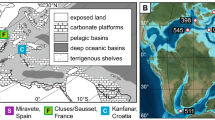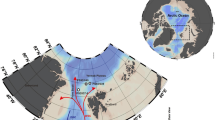Abstract
PLIOCENE-PLEISTOCENE palaeoclimatic investigations in the Southern Ocean have been carried out using five groups of microfossils: foraminifera1,2, calcareous nannofossils3, Radiolaria4–9, diatoms10, and silicoflagellates11. Radiolarian methods are particularly valuable in higher latitudes where carbonate sediments are susceptible to dissolution even in relatively shallow waters12,13. Established radiolarian techniques are based on oscillations of cold-water (Antarctic) relative to warmer-water radiolarian assemblages, established by determining their distribution in Recent sediments relative to the Antarctic Convergence (Polar Front)4. The cold-water assemblage used in these palaeotemperature determinations consists of eight species, whereas the warm-water assemblage consists of nine species4,9. Of the several dozen species known in Southern Ocean Quaternary sediments, these seventeen species represent more than 75% of the individuals4.
This is a preview of subscription content, access via your institution
Access options
Subscribe to this journal
Receive 51 print issues and online access
$199.00 per year
only $3.90 per issue
Buy this article
- Purchase on Springer Link
- Instant access to full article PDF
Prices may be subject to local taxes which are calculated during checkout
Similar content being viewed by others
References
Kennett, J. P., Deep-Sea Res., 17, 125 (1970).
Keany, J., and Kennett, J. P., Deep-Sea Res., 19, 529 (1972).
Geitzenauer, K. R., Nature, 223, 170 (1969).
Hays, J. D., Ant. Res. Ser., Am. geophys. Un., 5, 125 (1965).
Hays, J. D., Prog. Oceanog., 4, 117 (1967).
Hays, J. D., and Opdyke, N. D., Science, N.Y., 158, 1001 (1967).
Bandy, O. L., Casey, R. E., and Wright, R. C., Ant. Res. Ser., Am. geophys. Un., 15, 1 (1971).
Casey, R. E., The Micropaleontology of Oceans (edit. by Funnell and Riedel), 331 (1971).
Huddlestun, P., Deep-Sea Res., 18, 1141 (1971).
Donahue, J. G., Prog. Oceanogr., 4, 133 (1967).
Jendrzejewski, J. P., and Zarillo, G. A., Deep-Sea Res., 19, 327 (1972).
Kennett, J. P., Science, N.Y., 153, 191 (1966).
Fillon, R. H., Nature phys. Sci., 238, 40 (1972).
Watkins, N. D., and Kennett, J. P., Ant. Res. Ser., Am. geophys. Un., 19, 273 (1972).
Goodell, H. G., and Watkins, N. D., Deep-Sea Res., 15, 89 (1968).
Petrushevskaya, M. G., Biological Repts. Soviet Ant. Exp., 3, 1 (1967).
Petrushevskaya, M. G., The Micropaleontology of Oceans (edit. by Funnell and Riedel), 319 (1971).
Author information
Authors and Affiliations
Rights and permissions
About this article
Cite this article
KEANY, J. New Radiolarian Palaeoclimatic Index in the Plio-Pleistocene of the Southern Ocean. Nature 246, 139–141 (1973). https://doi.org/10.1038/246139a0
Issue Date:
DOI: https://doi.org/10.1038/246139a0
Comments
By submitting a comment you agree to abide by our Terms and Community Guidelines. If you find something abusive or that does not comply with our terms or guidelines please flag it as inappropriate.



